The die-cast car miniatures world provides a deep look into the miniature car history. It has become a beloved hobby for fans of all ages. These detailed scale models transform simple toys into treasures. Collecting these miniatures is both a hobby and a way to explore history and craftsmanship.
People love these die-cast cars for many reasons. Some love the nostalgia, others enjoy the automotive history, or the joy of having small versions of classic cars. The journey from their simple beginnings to today’s fame shows a vibrant culture. It connects with collectors everywhere.
Key Takeaways
- Die-cast car miniatures have a rich history and significant appeal as collectibles.
- The popularity of collecting these miniatures spans multiple generations.
- Detail and craftsmanship turn die-cast models into highly coveted items.
- Nostalgia and interest in automotive history drive the collecting trend.
- Die-cast car miniatures offer a journey through time and are more than just toys.
The Origins of Miniature Cars
The origins of miniature cars can be traced back to when the main forms of transport inspired toys. These little versions were first made from wood or tinplate. They showed off both playful imagination and crafty design skills.
Early Beginnings of Miniature Vehicles
The early beginnings of miniature vehicles were marked by skillful hands shaping wood and metal into small cars. These tiny models were carefully painted and cherished as treasures. The move to tinplate from wood brought about detailed and sturdy toy cars.
Development of Die-Cast Technology
The development of die-cast technology was a game-changer for making miniature cars. It allowed molten metal to be poured into molds for mass production. Companies like Meccano Ltd, with their Dinky Toys, were pioneers. They showed the world the precision and authenticity die-cast cars could achieve.
The Evolution of Die-Cast Cars
Die-cast cars have a colorful history filled with technological advances. They started simple but grew into detailed collectibles. Fans and collectors everywhere love these small cars.
Key Milestones in Die-Cast Manufacturing
Manufacturing breakthroughs really pushed die-cast cars forward. In the 1930s, using zinc and aluminum made models stronger and more detailed. Techniques like precision casting and electroplating also boosted their quality and looks.
“Technological evolution has made each generation of die-cast cars more impressive than the last, blending durability with intricate craftsmanship.”
Influence of Popular Culture on Design
Movies and TV shows have a big impact on die-cast car designs. Famous cars, like James Bond’s Aston Martin DB5 or the DeLorean, stand out. These models have grown beyond toys to become cultural symbols.
- James Bond’s Aston Martin DB5
- DeLorean from “Back to the Future”
- Batmobile from the Batman series
Iconic Models that Shaped the Market
Some die-cast models have been game-changers. Matchbox’s “Regular Wheels” series in the 1950s made car models more accessible. Hot Wheels then came along in the 1960s with low-friction wheels that changed how toy cars rolled.
- Matchbox’s “Regular Wheels” series
- Hot Wheels’ low-friction wheel models
- Dinky Toys’ detailed replicas
These moments highlight the amazing story of die-cast cars. Both in making and culture, they’ve grown from toys to treasures. As technology and tastes evolve, we’re eager to see where die-cast cars go next.
The Rise of Collecting Die-Cast Miniatures
Collecting die-cast miniatures has become more popular over time. For car lovers, it’s more than just collecting. It’s a way to remember the past, appreciate great workmanship, and sometimes even make money from it.

Reasons Behind the Collecting Trend
Why are more people collecting these? Nostalgia is a big part. Collectors want to remember good times from when they were young. These mini models are a way to hold onto those fun memories. Plus, the amazing detail in these models draws people who love art and engineering. And for some, these little cars are smart investments that can grow in value.
Notable Collectors and Their Contributions
Famous collectors have made this hobby popular. Like Jay Leno. He collects both real cars and miniatures, showing them on his show. Then there’s Bruce Pascal. He has an impressive Hot Wheels collection that’s well-known. Their passion has encouraged others to start collecting too.
| Notable Collector | Contribution |
|---|---|
| Jay Leno | Showcasing a diverse range of real and die-cast cars on his show |
| Bruce Pascal | Curating one of the world’s largest Hot Wheels collections |
Major Brands in Die-Cast Miniatures
In the world of die-cast miniatures, several top brands have really made a mark. They’ve not just led the way in the industry but also brought happiness to many collectors all over.
Hot Wheels and Matchbox: Pioneers in the Industry
Among the big names, Hot Wheels and Matchbox really stand out. Hot Wheels hit the scene in 1968, created by Mattel. They quickly became famous for their speedy race cars and eye-catching designs. Thanks to their focus on speed and fine details, Hot Wheels won the hearts of many fans.
Before Hot Wheels, there was Matchbox, launched by Lesney Products in 1953. Matchbox gained fame for their lifelike and sturdy mini vehicles. Their name comes from the original packaging, which resembled matchboxes. Both brands have greatly influenced many people’s childhoods and remain key players in the collectibles arena.
Dinky Toys and Their Historical Significance
Dinky Toys is one of the pioneering names in die-cast miniatures, starting in the 1930s. Collectors value these vintage die-cast cars for their rich history and craftsmanship. Dinky Toys played a big role in making die-cast models popular and setting high standards in the industry. They offered a wide variety of vehicles, including military tanks and high-end cars, which made them a notable figure in toy history.
Each of these major brands, from Hot Wheels and Matchbox to Dinky Toys, has played a significant role in the die-cast car evolution. They continue to inspire both young collectors and seasoned enthusiasts.
Tips for Collecting Die-Cast Cars
Starting your die-cast car collection is exciting and rewarding. Here, we share essential tips for those looking to start, maintain, and grow their collections.
How to Start Your Own Collection
First, decide what you want to collect. Choose based on brand, era, or model. Set a budget to keep your spending in check.
Look for cars at hobby shops, antique stores, and eBay. Connecting with other collectors can help you find rare items and get collecting advice.
Caring for and Displaying Die-Cast Models
Take good care of your models to keep them looking great. Dust them often with a soft cloth. Keep them away from direct sunlight and moisture.
When displaying them, consider using cases or shelves that protect and show off their beauty. UV-protected glass cases are great for keeping out harmful sunlight.
Understanding Value and Investment Potential
Knowing a die-cast car’s value requires understanding market trends. Models that are limited edition, in mint condition, or no longer made often are worth more.
Keep up with the market through forums, trade shows, and value guides. Save all original packaging and authenticity certificates to increase your collection’s value.
By following these tips, you’ll create a meaningful collection. It will reflect your passion while growing in value for future enjoyment and profit.

